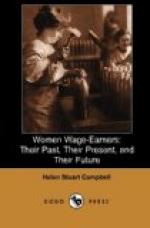Suggestive as these figures are, they are still more so when we come to their apportionment to States. They become then a history of the progress of trades, and women’s share in them; and a glance enables one to determine the proportion employed in each. In the table which follows, industries are condensed under a general head, no mention being made of the many subdivisions, each ranking as a trade, but going to make up the business as a whole. It is the result of statistics taken in fifty of the principal cities, and includes only those industries in which women have the largest share.[19]
=======================================================
============ | Total |Per Cent |Per Cent | | Number. |of Males.| of |Children. | | |Females. | ---------------------------+---------+---------+---------+--
------- Book-binding | 10,612 | 4,831 | 4,553 | 616 Carpet-weaving | 20,371 | 4,960 | 4,207 | 833 Men’s Clothing | 160,813 | 4,801 | 5,037 | 159 Women’s Clothing | 25,192 | 1,030 | 8,833 | 137 Cotton Goods | 185,472 | 3,457 | 4,914 | 1,629 Men’s Furnishing Goods | 11,174 | 1,140 | 8,560 | 300 Hosiery and Knitting | 28,885 | 2,602 | 6,130 | 1,268 Millinery and Lace | 25,687 | 1,120 | 8,637 | 243 Shirts | 6,555 | 1,481 | 8,000 | 513 Silk and Silk Goods | 31,337 | 2,992 | 5,232 | 1,776 Straw Goods | 10,948 | 2,991 | 6,850 | 154 Tobacco | 32,756 | 4,544 | 3,290 | 2,166 Umbrellas and Canes | 3,608 | 4,169 | 5,152 | 679 Woollen Goods | 86,504 | 54,544 | 3,395 | 1,174 Worsted Goods | 18,800 | 5,431 | 5,038 | 1,540 ============================================================
=======
In obtaining these averages, it was found necessary to equalize the returns of Pittsburg and Philadelphia, the former having but 4.55 per cent of women workers, while Philadelphia had 31. This resulted from the fact that the industries of Philadelphia are the manufacturing of textiles and other goods, which employ women chiefly; while Pittsburg has principally iron and steel mills. New York was found to have 31 per cent of women workers; Lowell, Mass., had 47.42, and Manchester, N.H., 53; Pittsburg and Wilmington, Del., having the lowest percentage.
The gain of women in trades over the census of 1870 was sixty-four per cent, the total percentage of women workers for the whole country being forty-nine. The ten years just ended show a still larger percentage; and many of the trades which a decade since still hesitated to admit women, are now open, those regarded as most peculiarly the province of men having received many feminine recruits. These isolated or scattered instances hardly belong here, and are mentioned simply as indications of the general trend. Wise or unwise, experiment is the order of the day, its principal service in many cases being to test untried powers, and break down barriers, built up often by mere tradition, and not again to rise till women themselves decide when and where.




